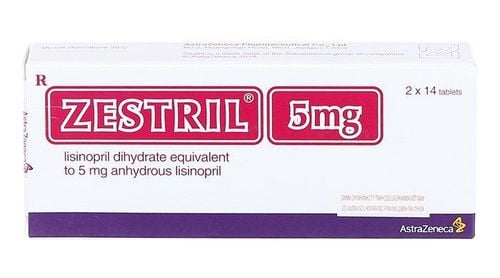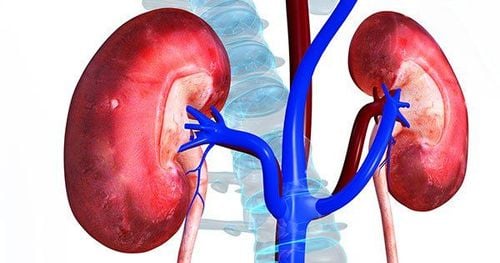This is an automatically translated article.
Metopram 10 is prepared in the form of tablets, packing specifications: Box of 2 blisters x 10 tablets; box of 3 blisters x 10 tablets and box of 10 blisters x 10 tablets. The main ingredient in the drug is Lisinopril (as lisinopril dihydrate) 10mg. Let's learn about the uses, usage and notes when using Metopram 10 in the following article.
1. Uses of Metopram 10
Metopram 10 is used in the treatment of the following conditions:
Hypertension: Use Metopram 10 alone or in combination with other antihypertensive drugs such as thiazide diuretics, alpha blockers or calcium channel blockers.. Treatment of heart failure: Use Metopram 10 in combination with cardiac glycosides and diuretics to treat congestive heart failure for patients who have used cardiac glycosides or diuretics alone without any effect. Hemodynamically stable acute myocardial infarction: Combination of Metopram 10 with thrombolytic drugs, Aspirin, beta-blockers to improve survival time for patients with acute myocardial infarction who are hemodynamically stable. Metopram 10 should be taken within 24 hours of a myocardial infarction. Indications Metopram 10 in the treatment of diabetic nephropathy.
2. Dosage, how to use Metopram 10
How to use the drug:
Metopram 10 is a long-acting ACE inhibitor, so the drug is taken orally once a day. Metopram dose 10 in adults:
Treatment of hypertension:
Metopram starting dose: Take 5-10mg/day, adjust Metopram dose according to the patient's clinical response. Metopram maintenance dose: Use 20-40mg/day. Vasodilator, treatment of congestive heart failure:
Initial dose of Metopram: Use 2.5 - 5mg/day, adjust Metopram dose according to the patient's clinical response. Maintenance dose: Use Metopram 10-20mg/day. Treatment of myocardial infarction:
Take Metopram with thrombolytics, low-dose aspirin and beta-blockers. Initial dose: Take Metopram 5mg within 24 hours after symptoms of myocardial infarction occur. 24 and 48 hours later, administer doses of 5 and 10 mg, respectively. Maintenance dose: Metopram 10mg/day, continuous treatment for 6 weeks. If there is myocardial failure, the course of treatment lasts more than 6 weeks. Dosage of Metopram 10 in children:
The efficacy and safety of Metopram in children has not been determined. Dosage of Metopram in the treatment of hypertension in patients with renal failure:
Creatinine clearance from 10-30ml/min: Take the starting dose of Metopram 2.5-5mg/time/day. Creatinine clearance < 10 ml/min: Initial dose of Metopram is 2.5 mg/time/day. Then adjust the dose of Metopram based on drug tolerance and blood pressure response of each patient, up to a maximum of 40mg/time/day. Treatment of heart failure, with hyponatremia:
Serum sodium concentration < 130 mEq / liter or creatinine clearance < 30 ml / min, serum creatinine > 3 mg / deciliter: The initial dose of Metopram must be reduced to 2.5 mg. After the first dose of Metopram, the patient should be monitored for 6-8 hours until blood pressure stabilizes. Treatment of myocardial infarction and renal failure:
If the serum creatinine level is > 3mg/decilit or 100% increase above normal in treatment, Metopram must be stopped. If the treatment regimen needs to be combined with diuretics in patients with severe renal impairment, loop diuretics such as furosemide should be more effective than thiazides. Dosage of Metopram 10 above is for reference only. The specific dose of Metopram 10 will depend on the condition and the progression of the disease. To get the right dose of Metopram 10, patients need to consult their doctor/pharmacist.
3. Metopram 10 overdose and treatment
Manifestation of Metopram overdose may be a decrease in blood pressure.
Treatment: Intravenous isotonic saline solution. Lisinopril can be removed by hemodialysis.
4. Contraindications to taking Metopram 10
Do not use Metopram 10 for the following patients:
Have aortic valve stenosis; Have obstructive cardiomyopathy; Renal artery stenosis bilaterally or in a solitary kidney; Patients with hypersensitivity to the drug components contained in Metopram 10.
5. Drug interactions
Possible interactions when using Metopram 10 with the following drugs:
Sympathomimetic; Non-steroidal anti-inflammatory drugs; Ciclosporin; Potassium-sparing diuretics; Potassium supplements; Increases concentration and toxicity of Lithium, Digoxin when used concomitantly with Metopram 10; Estrogens. To avoid unwanted interactions when using Metopram 10, patients should inform their doctor/pharmacist of all medicines, dietary supplements or vitamins, herbs they are taking.
6. Side effects of Metopram 10
Common side effects:
Headache. Prolonged dry cough. Uncommon side effects:
Nausea; Loss of taste; Diarrhea; Lower blood pressure; Skin rash; maculopapular, urticaria; Tired; Proteinuria; Fever or joint pain. Rare side effects:
Angioedema ; Hyperkalemia; Confusion, agitation; Increased numbness, tingling in the lips/hands and feet; Shortness of breath, chest pain; Neutropenia and agranulocytosis; Jaundice, liver cell damage; Cholestasis; Pancreatitis . During the course of treatment, if there are any abnormal symptoms suspected of using Metopram 10, the patient should notify the treating doctor/pharmacist for timely treatment.
7. Be careful when taking Metopram 10
Care should be taken when using Metopram 10 for the following subjects:
People with pre-existing kidney disease or taking high doses of Metopram 10 need to be monitored for proteinuria. Routine white blood cell testing for people with collagen vascular disease or taking immunosuppressive drugs. People with heart failure or the ability to lose salt and water. Limit this by giving a low starting dose of Metopram 10 and taking it at bedtime. Since serum potassium levels may increase during treatment with Metopram 10, caution should be exercised if potassium-sparing diuretics or potassium supplements are co-administered. Metopram 10 has a high risk of causing morbidity and mortality to the fetus/newborn if the mother takes this drug during pregnancy. Therefore, Metopram 10 should not be used during pregnancy. It has not been determined whether Metopram 10 is excreted in human milk. Therefore, Metopram 10 should not be used by women who are breastfeeding. Metopram 10 does not affect people who drive and operate machinery. However, caution should be taken because the drug can cause headaches and fatigue for users. The article has provided information about the uses, doses and precautions when using Metopram 10. To ensure safety for your health and maximize the effectiveness of your treatment, you need to take Metopram 10 exactly as directed by your doctor.
Please dial HOTLINE for more information or register for an appointment HERE. Download MyVinmec app to make appointments faster and to manage your bookings easily.













